- Home
- Stephen E. Ambrose
Supreme Commander Page 3
Supreme Commander Read online
Page 3
Like his colleagues in WPD, Eisenhower had no illusions about saving the Philippines, but he did want a larger commitment to the Far East. On New Year’s Day he noted on his desk pad, “I’ve been insisting Far East is critical—and no other side shows should be undertaken until air and ground there are in satisfactory state.” The “side shows” he referred to were plans to ship American forces to Northern Ireland to relieve the British (code name MAGNET), or a possible operation against French North Africa (code name GYMNAST). Both projects were then being discussed by the British and American Chiefs of Staff, meeting in Washington. On January 17, noting that the whole situation in the Pacific was critical, he scribbled on his pad, “My own plan is to drop everything else—Magnet, Gymnast, replacements in Iceland—and make the British retire in Libya. Then scrape up everything everywhere and get it into NEI [Netherlands East Indies] and Burma.”15
On January 14 Eisenhower got a convoy scheduled to take American troops to Northern Ireland reduced in size. He used the space saved to ship Air Force personnel, supplies, and aircraft to the Southwest Pacific.16 This slowed down MAGNET and GYMNAST, but it did not mean “dropping everything else” and did little to help the situation in the Far East, since it took weeks to reload the ships, turn them around, and get them to their destination. The reinforcements made no practicable contribution to the defense of the Netherlands East Indies. Eisenhower’s efforts to get B-17s into Java, the most directly threatened of the NEI islands, were likewise piecemeal and for the most part unsuccessful. There were a variety of reasons; the most important were simple absence of planes and crews and the tremendous distances involved.
Always present in Eisenhower’s mind was the problem of shipping. The United States, unprepared for the scope of the Japanese onslaught, was incapable of meeting the enemy effectively with the forces available to it. The British, in their first meetings with the Americans, were shocked to find how little shipping their new allies had. The maximum American troop lift for January was 25,000 men, for February, 18,000 and for March 15,000.17 In the middle of January Eisenhower scraped up 21,000 men with ships to carry them to Australia but he noted on his desk pad, “I don’t know when we can get all their equip. and supply to them. Ships! Ships! All we need is ships!” Then, as an afterthought, he added, “Also ammunition—A.A. guns—tanks—airplanes.”18
Two events in February illustrated the frustrations inherent in the attempt to hold onto something north of Australia in the Southwest Pacific. By the middle of the month everyone except the Dutch had given up on holding Java, but it seemed that something should be done. Eisenhower and WPD got the aircraft tender Langley, with a cargo of thirty-two P-40s, ordered to Tjilatjap, on the south coast of Java, along with the freighter Seawitch, which had twenty-seven P-40s in her hold. When Langley was almost within sight of Java, Japanese patrol planes spotted and sank her. Seawitch arrived in Java on the eve of the final invasion and had to dump her cargo of P-40s, still crated, into the sea to prevent their capture.19
Under the circumstances, the tension in the War Department could almost be heard. “Tempers are short!” Eisenhower noted in January. “There are lots of amateur strategists on the job—and prima donnas everywhere.” A little later he complained, “There’s a lot of big talk and desk hammering around this place—but very few doers! They announce results in advance—in a flashy way and make big impressions but the results often don’t materialize and then the workers get the grief.”20
As the stopgap measures failed to work and the pattern of Japanese aggression became clearer, Eisenhower began to have second thoughts about his plan to drop everything else and go all out in the Pacific. In the middle of January he talked with Major General Joseph T. McNarney, a West Point classmate and Army Air Corps officer who had recently returned from London to join the War Department. McNarney had no involvement in the Far East and would only talk to Eisenhower about Europe. He was most convincing. On January 22 Eisenhower noted the results on his pad: “The struggle to secure the adoption by all concerned of a common concept of strategical objectives is wearing me down. Everybody is too much engaged with small things of his own”—which was as true of Eisenhower as it was of anyone else.
Eisenhower then announced his full conversion to the Europe-first doctrine. “We’ve got to go to Europe and fight,” he declared, “and we’ve got to quit wasting resources all over the world—and still worse—wasting time. If we’re to keep Russia in, save the Middle East, India and Burma; we’ve got to begin slugging with air at West Europe; to be followed by a land attack as soon as possible.”21 This was also, of course, the trend of Marshall’s thinking.
Eisenhower spent the rest of his tour in the War Department working assiduously for the Europe-first program. It did not mean that he was abandoning the Pacific, but rather that he had recognized the futility of piecemeal reinforcements and the need to draw back to Australia, lick the wounds, establish a workable defensive line, and meanwhile go over to the offensive in Europe. The temptations to change the basic RAINBOW 5 concept were always great, and it was difficult not to yield to them as the Japanese advance carried the enemy far beyond the points the Allies had imagined the Japanese could attain, but for the most part Eisenhower and WPD held firm. Events strengthened his hand, for short of Australia there was not much left to be saved. On the day Eisenhower wrote of the necessity to start an air campaign in West Europe, MacArthur fell back to his final defensive position on the Bataan Peninsula and the outer defenses of Singapore collapsed. The Japanese were gathering their strength for the final assault on the Netherlands East Indies and none of the governments resisting them had anything like the forces needed to hold out.
On January 22 Eisenhower wrote that he, Colonel Thomas Handy of WPD, and McNarney “stick to our idea that we must win in Europe.” Eisenhower realized “it’s going to be one hell of a job—but, so what?” In a sharp criticism of WPD’s action up to that time, he pointed out “we can’t win by sitting on our fannies giving our stuff in driblets all over the world—with no theater getting enough.”22 The scope of Japanese success had forced the planners to reconsider RAINBOW 5—no one had counted on losing Singapore, for example—and gave added weight to MacArthur’s program of turning full force on the Japanese first. The argument would continue throughout the war, but under Marshall’s strong direction the War Department never wavered after the first couple of months.
In any case it is hard to see what more Washington could have done to save the Philippines. Long after the situation on Bataan had become irretrievable the War Department sent whatever reinforcements became available to the Pacific. As late as April 1942 no American forces of any size had gone to the British Isles. By the time sizable American forces were available for deployment overseas, the Philippines had already fallen. The Japanese had sealed their fate on the first day of the war by eliminating the Navy’s striking force. Even had the Navy gotten through, however, the Army had practically nothing to send. MacArthur could have held on longer with more equipment and especially air support, but the necessary units to retrieve the situation simply were not available. Money could not buy them—they had to be built and trained, and that took time.
Later that spring Eisenhower explained the predicament to his brother Edgar, who had said he wanted to get the war over with in a hurry. Eisenhower replied that he too was anxious to end it, but “there are so many things that we didn’t do in the past twenty years that their accomplishment now is a matter of weeks and months. It cannot be done in a minute. There is no use going back over past history either to regret or condemn; although I was one of those that for the past two years has preached preparedness and tried to point out the deadly peril into which the United States was drifting.” Eisenhower saw no point in an “I told you so attitude,” especially since “we have got a fearful job to perform and everybody has got to unify to do it.” The only consideration, he added, was the defeat of the Axis powers, for “if they should win we would really learn somet
hing about slavery, forced labor and loss of individual freedom.”23
Eisenhower did try to use money to save the Philippines. Marshall had sent former Secretary of War Patrick J. Hurley to Australia with a brigadier general’s star on each shoulder and orders to use the $10,000,000 cash he carried to hire blockade runners. Eisenhower sent Hurley a series of messages, urging him to set prices high enough “to insure utmost energy and daring” on the part of ship commanders, and demanding redoubled efforts. The risks, however, discouraged most sea captains, and few ships could be found at any price. Despite liberal monetary offers and feverish activity, Hurley got only six ships started; of these only three got through. One reached Mindanao and two got to Cebu, but only 1000 of the 10,000 tons the ships carried reached the garrison in Luzon.24
It took weeks to convince the enthusiastic Hurley that he was not helping his old friend MacArthur, but finally he recognized what the War Department had seen all along. “We did not have the ships, the air force or ground forces necessary to make the operation successful,” Hurley declared. “We were out-shipped, out-planed, out-manoeuvred, and out-gunned by the Japanese from the beginning.”25
Manuel L. Quezon, President of the Philippines, could not accept that conclusion. Dying of tuberculosis on a cot in the crowded tunnel of Corregidor, humiliated at the thought of Japanese troops in the presidential palace in Manila, frenzied because he would never live to see his country a free republic, Quezon blamed Washington for his desperation and decided that only shock action could retrieve the situation and force the United States to send help. If the United States did not intend to defend its colony, he told Roosevelt, it and Japan should be invited to withdraw troops, with the islands being neutralized. Since the Japanese already held Manila and badly needed the ports of the Philippines, the suggestion was absurd. Quezon knew that; so did MacArthur. But, like Quezon, MacArthur was ready to try anything. In forwarding Quezon’s proposal, MacArthur neglected to say that he disagreed with it. Rather, he said the plan “might offer the best possible solution of what is about to be a disastrous debacle.” If the Japanese accepted, the United States would lose no military advantage, and if the Japanese rejected the proposal it would be a psychological gain for the United States.26
On February 9 Marshall and Secretary of War Harry Stimson discussed the proposal with President Roosevelt. “We can’t do this at all,” Roosevelt firmly declared, and asked Marshall to prepare a reply.27 Marshall had Eisenhower draft one for the President’s signature.
Eisenhower began by authorizing MacArthur to arrange for the capitulation of the Filipino units but declining even to consider the neutralization of the islands. MacArthur should keep the flag flying “so long as there remains any possibility of resistance.” Eisenhower emphasized that the duty and necessity of resisting Japanese aggression to the last transcended in importance any other obligation facing the United States in the Philippines. Eisenhower had the President express great sympathy for the plight of those on the island (Quezon and Eisenhower were close friends), then declare that the service the troops on the Philippines could render to the country in the struggle then developing “is beyond all possibility of appraisement.”28
MacArthur replied, with some heat, that he had no intention of surrendering the Filipino units and planned to fight on until his forces in Bataan were destroyed.29 He would then take up the struggle on the island of Corregidor. Marshall, horrified at the idea of MacArthur going down with the garrison, decided to order him to leave the islands and go to Australia. The whole thing had to be handled with some care, for there was always a possibility that MacArthur would strike a pose, refuse to leave, and fight until killed or captured. Eisenhower took care of the delicate arrangements, and eventually MacArthur agreed to leave.30
In the second week of March MacArthur made his dramatic escape on a PT boat from the Philippines. On March 17 he arrived in Darwin, from whence he proceeded to Melbourne. The trip signified an end and a beginning; the end of the Allied attempt to hold onto anything substantial in the Southwest Pacific north of Australia, as well as the end of a policy of meeting Japanese thrusts with haphazard measures, and the beginning of the implementation of a well-thought-out, comprehensive, world-wide strategy.
It did not mean the abandonment of MacArthur’s successor, Lieutenant General Jonathan Wainwright, to his fate. Eisenhower kept trying, despite increasing feelings of helplessness, to get aid into the islands. “For many weeks—it seems years—I’ve been searching everywhere to find any feasible way of giving real help to the P.I.,” he noted in his desk pad. “We’ve literally squandered money; we wrestled with the Navy, we’ve tried to think of anything that might promise even a modicum of help. I’ll go on trying, but daily the situation grows more desperate.”31
Marshall had asked Eisenhower to see what he could do about saving the Philippines and, by implication, to mollify MacArthur. In addition, Marshall had wanted Eisenhower to attempt to retrieve the situation in the Southwest Pacific. In none of these objectives had Eisenhower achieved success. But he had never thrown up his hands at the herculean task, had shown himself willing to assume responsibility, and had made himself invaluable to Marshall not only in handling details but in dealing with larger policy questions. Eisenhower had done as much as any man could have, but his efforts were fruitless.
* In the first six months of the war, when they were on the offensive, the Japanese were always careful to stay within range of land-based fighter cover. Their victories were sensational but their operations were never risky.
CHAPTER 2
Establishing the Organization and the Strategy
The American problems in 1942 were to build an army, secure the shipping to get it overseas, establish an organization through which agreement could be reached with the British on a strategy to defeat Germany, and resist the pull of the Pacific. The Army’s contribution to the solution to these problems was Marshall’s responsibility and therefore Eisenhower’s job. The way in which Eisenhower carried it out would depend, in part, on the nature of his relations with the Chief. Establishing an intimate relationship would not be easy, for the Chief was a stern man.
George Marshall’s back had no bend to it. He carried himself lightly, with great dignity. His movements were deliberate, his shoulders square, his dress immaculate. His face looked as if it were chisled out of stone. Quietly handsome, a little too thin, he had a determined jaw, a firm mouth, and deep-set, penetrating eyes. The Chief of Staff commanded attention.
He was a cold, aloof person who forced everyone to keep his distance. Franklin Roosevelt had tried at their first meeting to call him “George,” but Marshall let the President know the name was “General Marshall,” and “General Marshall” it remained. He had few intimate friends. When he relaxed he did it alone, watching movies or puttering in his garden. His sense of humor was limited at best and he kept a tight grip on his emotions. If he had a weakness, it was that his sense of duty was so highly developed that he seemed almost inhuman, a sort of intellectual superman, and made small allowance for failings in others. Throughout his career he kept a little Black Book in which he listed the names of officers who had, at one time or another, disappointed him. When war came he used the book ruthlessly, shucking aside dozens of high-ranking officers without explanation or apology.1
To those who could do the work and who shared his sense of duty, Marshall was intensely loyal. He also felt deep affection toward them, but something, perhaps a natural shyness, or a fear of indulging in emotion, or a half-thought-out notion that it would make him appear weak, prevented him from ever showing his feelings, even to someone as close to him as Eisenhower came to be. Hardly anyone could resist Eisenhower’s infectious grin and he was known throughout the Army by his catchy nickname “Ike.” Eisenhower worked under Marshall for four years. For the first six months they met several times a day; thereafter they communicated almost daily and met often. Eisenhower was Marshall’s personal protégé, and in four years the
younger man never let the Chief of Staff down on a major matter. Yet in all that time Marshall never called him anything but “Eisenhower.” (Only one time did Marshall slip and call him “Ike”; to make up for it he used “Eisenhower” five times in his next sentence.2)
Once, when Eisenhower was in Marshall’s office, a detail arose about an officer’s promotion. After settling it, Marshall leaned forward and explained to Eisenhower his attitude toward promotion. “The men who are going to get the promotions in this war are the commanders in the field,” he declared, “not the staff officers who clutter up all of the administrative machinery in the War Department.… The field commanders carry the responsibility and I’m going to see to it that they’re properly rewarded so far as promotion can provide a reward.” In the last war, Marshall explained, the staff had gotten everything. This time he was going to reverse the process.
“Take your case,” he continued, looking right at Eisenhower. “I know that you were recommended by one general for division command and by another for corps command. That’s all very well. I’m glad they have that opinion of you, but you are going to stay right here and fill your position, and that’s that!” He had already made Eisenhower head of WPD, but no promotion accompanied the advance in status and responsibility.

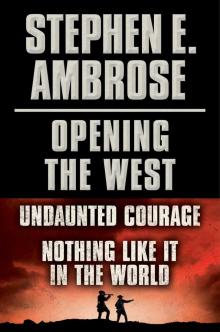 Undaunted Courage
Undaunted Courage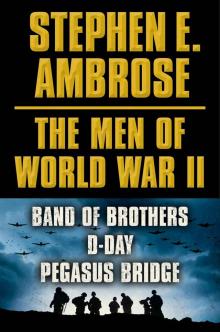 The Victors: Eisenhower and His Boys
The Victors: Eisenhower and His Boys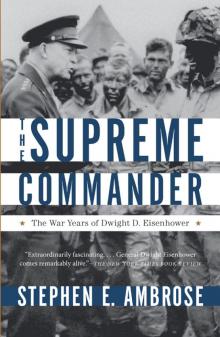 The Supreme Commander
The Supreme Commander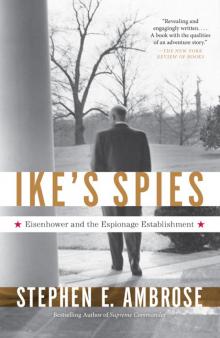 Ike's Spies: Eisenhower and the Espionage Establishment
Ike's Spies: Eisenhower and the Espionage Establishment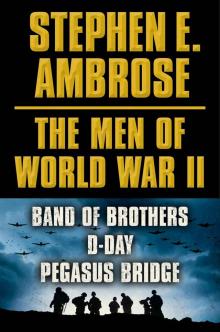 The Men of World War II
The Men of World War II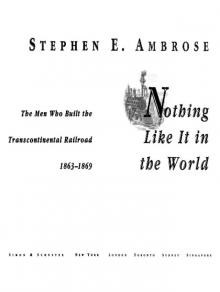 Nothing Like It in the World The Men Who Built the Transcontinental Railroad 1863-1869
Nothing Like It in the World The Men Who Built the Transcontinental Railroad 1863-1869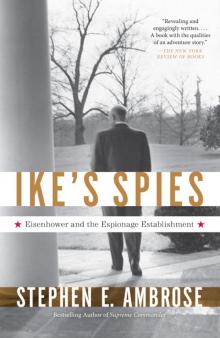 Ike's Spies
Ike's Spies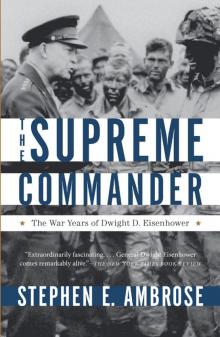 Supreme Commander
Supreme Commander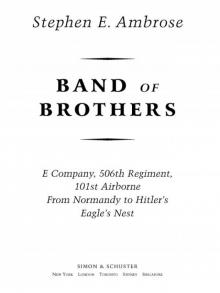 Band of Brothers
Band of Brothers